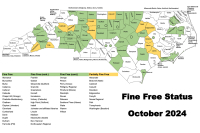Schools weigh cost of increased safety
 Officer Michael Harrison has confiscated everything from buck knives and Airsoft pistols from students at Swain High — but never a real gun. Until last week.
Officer Michael Harrison has confiscated everything from buck knives and Airsoft pistols from students at Swain High — but never a real gun. Until last week.
Harrison and the principal discovered a .22 Remington rifle and assorted ammunition in the tool-box of student’s pick-up truck left behind in the school parking lot after the 17-year-old was arrested for unrelated charges.
Although there was no indication that the student planned to use the gun at school — Harrison said he might actually encounter more guns if students’ cars were searched more frequently — the notable incident had a strange timing of its own.
The night before, Swain County Sheriff Curtis Cochran made a case to county commissioners for more deputies at schools. The county had a school resource officer at its middle and high school, but not at its two elementary schools.
Commissioners approved money to add the two new positions — becoming the only county in the region to fund officers in their elementary schools.
Cochran said he had been requesting money for more school resource officers for years, but the shooting rampage at Sandy Hook forced his request to be taken more seriously this time around. Then the gun was found.
Related Items
“I think that really put the nail in the coffin as far as need for the officers,” Cochran said. “And it helped commissioners to know they made the right decision.”
Although Swain’s swift action to increase school resource officers on the heels of Sandy Hook make it the first to do so, many mountain counties are having similar discussions — including Haywood, Jackson and Swain counties.
With school safety taking on new importance for parents, school administrators and school board members have found themselves on the receiving end of dozens of parents’ concerned phone calls.
Jackson County Schools Superintendant Mike Murray said he has personally addressed every phone call, letter and email he’s received since before Christmas about school safety.
One recurring demand, if carried out, would mark a change he has yet to witness in more than 20 years working in public education throughout the region: armed guards at each school.
The recent shooting, which took place in an elementary school, could change the expectations of school resource officers.
Rather than primarily addressing a school’s internal problems — such as fights, drugs and delinquency, usually more prevalent among older students — officers would become armed sentries protecting the school from the outside world.
“The role of the resource officer has really changed in all of this,” Murray said. “Parents are saying they’d like to see armed guards with guns.”
Murray said in the three school districts he has worked — Buncombe, McDowell and Jackson counties — he has never seen an armed officer assigned to an elementary school.
Sometimes, the most effective role for a resource officer is identifying and working with problem students as a preventative measure to stop them from walking into the school with a gun, Murray said. Again, it’s one reason officers are more common at middle and high schools, where threats and potential crimes come from within the student body.
Thus far, Jackson County School District officials have charged a task force with assessing school safety in the county and coordinated with state and local law enforcement to increase their presence at schools in the district.
Murray said he hasn’t ruled out the next step — a funding request to county commissioners to increase the number of full-time school resource officers — but then added that he did not think Jackson County schools are in an elevated state of danger.
“To be honest, I drive up every day with my 13-year-old daughter to drop her off at school.” Murray said. “I would not drop my child off if I felt I was putting her in an unsafe situation.”
Officers for hire
The elevated safety concerns in Western North Carolina, and across the country, may not be forceful enough to overcome the budget restrictions however. Local districts are still reeling from staffing shortages due to budget constraints, and paying for an additional officer with a gun, car, salary and benefits at each school is not cheap.
Swain County and its local school district will pay nearly $90,000 more each year for the two additional officers commissioners approved last week, and that doesn’t cover the start-up cost of purchasing equipment and a vehicle for each of the officers.
Jackson County Public Schools already have $160,000 budgeted this year to fund their three school resource officers and had to purchase their cars two years ago. To place an officer in each of its nine district schools would be a significant expense.
“I’m not saying that’s off the table,” Murray said. “But we’re already spending quite a bit of money to have our officers in schools.”
Education is already strapped for funding. Jackson County Public Schools has 40 fewer positions now than three years ago, and Haywood County Schools lost 129 full-time positions during the last the seven years.
In Haywood County, Superintendant Anne Garrett has already done the math on putting an armed officer in each of the county’s 16 schools to watch over the nearly 8,000 students that fill their halls.
“We’d love to have them at all of our schools,” she said. “But you’re looking at over $1 million.”
The first school resource officer in Haywood County was placed at Waynesville Middle School, approximately 15 years ago thanks to a federal grant at the time.
Today, Haywood has five school resource officers — one at both the main high schools, one at the alternative high school, one at Waynesville Middle and a shared officer between Canton and Bethel middle schools.
Now Garrett and other education officials are evaluating safety at all Haywood’s schools and exploring alternatives other than armed officers, such as physical features.
North Canton Elementary will be a pilot school in the coming weeks to test a security system — one that keeps the school’s doors locked to the outside and only allows visitors buzzed in after mugging for a security camera.
If proven effective, the buzz-in system will be expanded to other schools, primarily rural ones like the Bethel Elementary School, where it could be a matter of minutes before a sheriff’s deputy arrives in case of an emergency.
But, even Garrett noted that there are shortcomings in either method of security, whether it’s armed personnel or locked doors, especially at the larger school campuses where there are too many doors to monitor and a lot of ground for a school officer to cover.
“I can’t say we can handle every situation,” Garrett said. “But we certainly hope we’re prepared.”
More guns versus less guns
Although the prospect of spending millions of dollars to place officers in every school may not be the most fiscally sound plan during the ongoing recession, Macon County Sheriff Robert Holland fears the alternative. From local parents to high-ups in the National Rifle Association, a call has emanated for armed volunteers in the schools.
To prove his point, Holland staged a role-playing skit at last week’s Macon County commissioner meeting.
During the scenario, an “armed” county commissioner was told to run out of the room and into the hallway following “gun shots.” They found a man with a gun standing over a woman lying on the floor.
When it was Commissioner Ronnie Haven’s turn, he “shot” the man dead. During Commissioner Jimmy Tate’s turn, he bull rushed the man.
Then came the twist. In Holland’s role-playing scenario, the man with the gun was detaining a deranged pregnant woman who had just shot a teacher. He had been able to wrestle the gun away and wait for the police to arrive, until he was mistakenly as the assailant and shot or tackled.
Holland was trying to make a point.
“For those people being very boisterous, saying ‘Put the cafeteria lady with a gun, put the principal with the gun,’ I wanted to make them take a second look at it,” Holland said. “We need to have cops remain cops and teachers remain teachers.”
Holland is a proponent of expanding the number of school resource officers in Macon County schools. But to increase from the four current officers to 10 — enough to cover all of its schools — the cost would be an extra half-a-million dollars each year.
Holland hasn’t made the request to commissioners. But, he wants the discussion about school safety to begin.
To Holland, wanting an officer in each school isn’t about the threat of an unlikely mass killing. It’s about having school resource officers do what they do best — provide legal assistance to administrators, help with certain types of counseling and classroom instruction, and educate students about street safety.
The school resource officer at Pisgah High School in Haywood County, for example, teaches a self-defense class each semester geared toward girls.
Of course, the added safety factor in case of a shooter is also important, Holland said.
“Do we have safe schools in WNC?” Holland asked. “Absolutely, but we could make them even safer.”
But one Franklin town alderman is not jumping on the school resource officer bandwagon, at least not yet. Bob Scott, a former military officer and captain in the Macon County Sheriff’s Office, questioned the rationale that a armed cop, or an armed anybody, in a school would be a deterrent for a deranged killer.
“Usually these shootings are very well planned out, and I’m not sure school resource officers would stop anyone,” Scott said. “But that’s probably a very unpopular view of the situation.”
Furthermore, Scott said, the county and local municipalities, which sometimes fund officers for school’s within their limits, need to determine if the money being proposed for additional school officers might not be spent better someplace else. He said it may reflect poorly in terms of a communities’ priorities, taking into account current cuts to education.
“We’re talking about a situation where we have more guns and less teachers,” Scott said. “And I’m not sure that our schools are unsafe.”
School resource officers by county
Haywood: 5
Macon: 4
Jackson: 3
Swain: 4 (just upped from 2 last week)
Average cost of a school resource officer*
Salary: $31,000 per year
Benefits: $15,000 per year
Equipment, vehicle and training: $40,000 in start-up
Fuel, maintenance and other expenses: $3,000 per year
* Based on local agency estimates.









